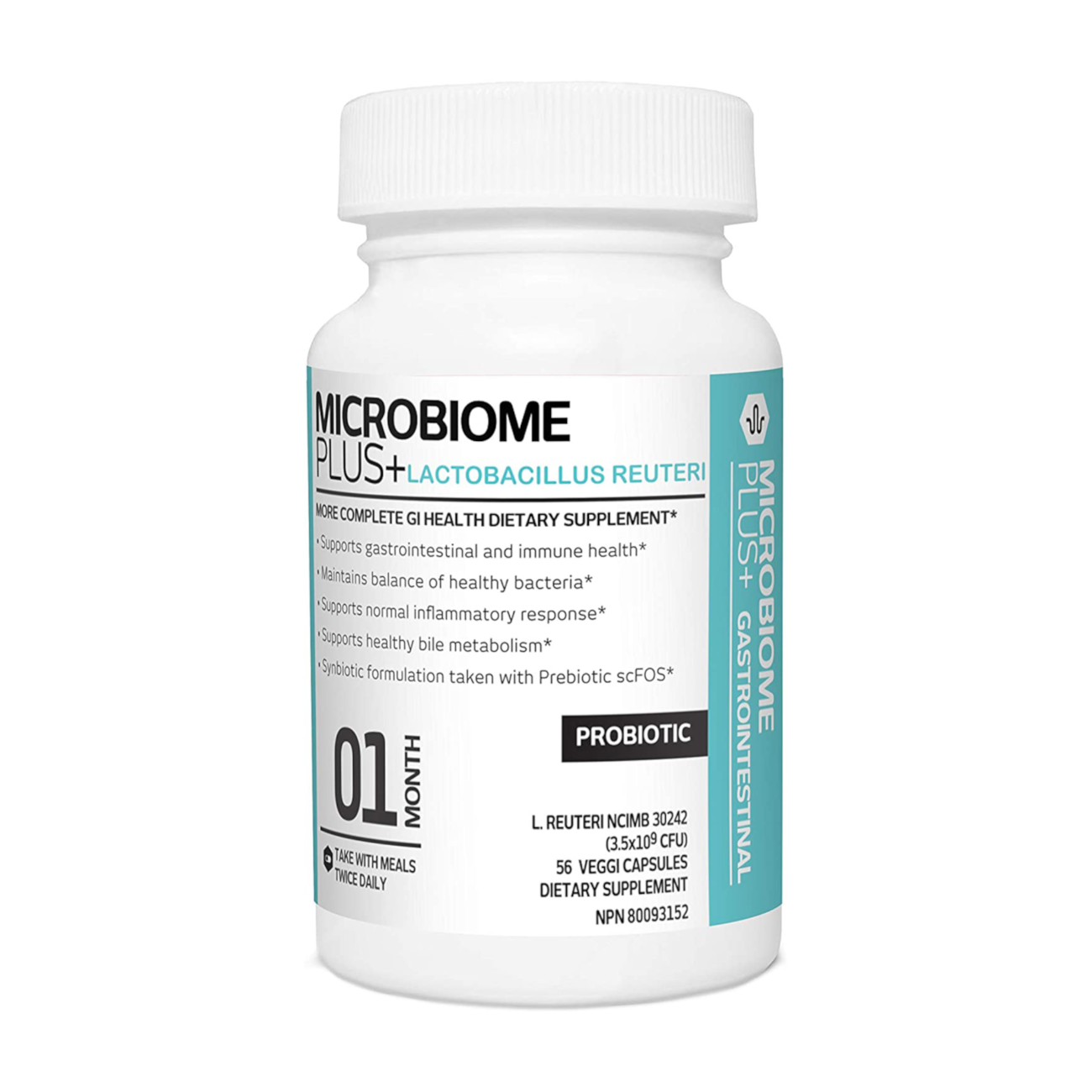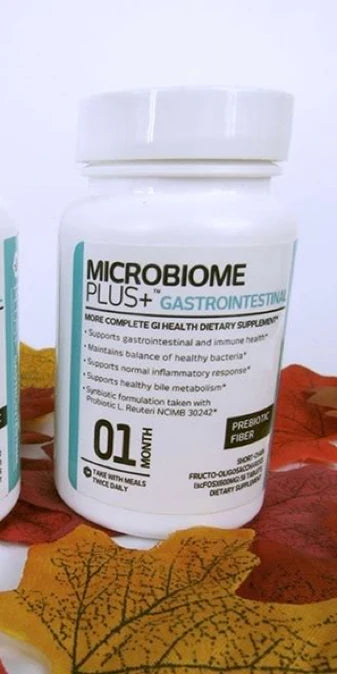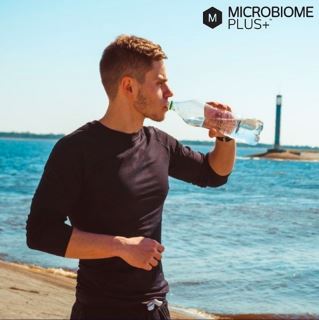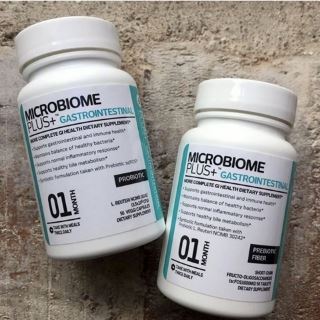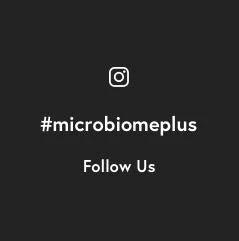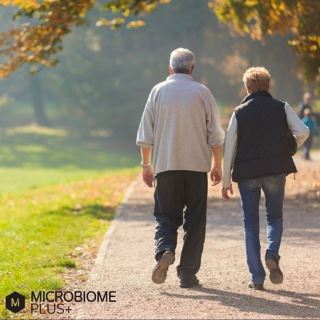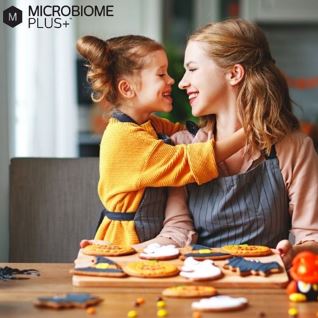The Microbiome and Bile Metabolism
The Microbiome
Your microbiome performs essential functions for your body, it is important that it is healthy and balanced1-3.
- Recent science shows that your early childhood4, 5, modern medicine6, and diet7 could have contributed negatively to the function of the microbiome and thus your health
- Bile metabolism is an important function of the microbiome and poor bile metabolism can lead to disease8-15
- Regaining microbiome and bile metabolism health requires serious lifestyle changes and or specifically formulated dietary supplements
The microbiome is the community of natural and essential organisms that live in your gut and perform functions necessary for your health like helping to digest your food2, ensuring appropriate immune function3, and maintaining your metabolic health16, 17.
The bacteria that live in your gut are essential and good for your health.
The microbiome is assembled and shaped between the ages of 0-4 years old and it has been shown recently to be negatively affected by C-section delivery4, insufficient breastfeeding18, antibiotic use6, an overly hygienic environment19, and poor diet7.
The health of your microbiome is largely a result of your childhood and diet, but is also the result of environmental factors such as the use of oral antibiotic and the presence of disease6, 20, 21.
The Microbiome of people with cardiovascular disease22, irritable bowel syndrome (IBS)10, irritable bowel disease (IBD)13, low vitamin D23 and osteoporosis24, and other diseases such as obesity25, liver disease26, and type two diabetes mellitus (T2DM)27 are notably different from those who are considered to be healthy.
The differences between a normal and unhealthy microbiome can be the result of disease or can be the cause of disease, both having a negative impact on your health.
To help restore your microbiome you must significantly and permanently change your diet by supplementing your diet with the specific bacteria required.
One important function of your microbiome is maintenance of a healthy bile metabolism.28-30 Bile is involved in digestion of food, absorption of fat, absorption of cholesterol, removal of cholesterol from the body, production of hormones, absorption of vitamins, production of vitamins, and act on receptors found to be essential in weight management and glucose metabolism.
Healthy bile metabolism in the gut is important for the regulation of cholesterol balance28, 30, inflammation leading to IBD13, 14, in irritable bowel syndrome (IBS)10, severe types of diarrhea31, and maintaining healthy levels of vitamin D and calcium in blood23, 32.
Bile metabolism can be disrupted by a poorly formed or damaged microbiome (bacteria in your gut)10, 13, 14, 28, 33. Permanent and stringent changes in your diet and daily supplementation are the only ways to repair the microbiome and restore its function.
For people who have cardiovascular disease, low vitamin D and osteoporosis, and IBD, IBS, and some sever types of diarrhea there is evidence that your microbiome and bile metabolism could be causing and or could be affected by your disease and that daily supplementation of your microbiome with L. reuteri NCIMB 30242 bacteria can help to boost and restore the normal balance of the microbiome and bile metabolism.
What is the Microbiome?
The human microbiome is the population of more than 100 trillion microorganisms that live in our gut, mouth, skin and elsewhere in our bodies34. These microbial communities have numerous beneficial functions relevant to supporting life. They are needed to digest food, to prevent disease-causing bacteria from invading the body, to develop and maintain the immune system, and to synthesize essential nutrients and vitamins.
The total number of genes associated with the human microbiome exceeds the total number of human genes by a factor of 100-to-one. With the advancement of genomic technologies, the capacity of this “second genome” to influence health can now be harnessed as a function of the whole community.
References
-
1O’Hara,A.M. & Shanahan,F.
The gut flora as a forgotten organ. EMBO Rep. 7, 688-693 (2006). -
2Gill,S.R. et al.
Metagenomic analysis of the human distal gut microbiome. Science 312, 1355-1359 (2006). -
3Chow,J., Lee,S.M., Shen,Y., Khosravi,A., & Mazmanian,S.K.
Host-bacterial symbiosis in health and disease. Adv. Immunol. 107, 243-274 (2010). -
4Dominguez-Bello,M.G. et al.
Delivery mode shapes the acquisition and structure of the initial microbiota across multiple body habitats in newborns. Proc. Natl. Acad. Sci. U. S. A 107, 11971-11975 (2010). -
5Palmer,C., Bik,E.M., DiGiulio,D.B., Relman,D.A., & Brown,P.O.
Development of the human infant intestinal microbiota. PLoS. Biol. 5, e177 (2007). -
6Sullivan,A., Edlund,C., & Nord,C.E.
Effect of antimicrobial agents on the ecological balance of human microflora. Lancet Infect. Dis. 1, 101-114 (2001). -
7Wu,G.D. et al.
Linking long-term dietary patterns with gut microbial enterotypes. Science 334, 105-108 (2011). -
8Mudaliar,S. et al.
Efficacy and Safety of the Farnesoid X Receptor Agonist Obeticholic Acid in Patients With Type 2 Diabetes and Nonalcoholic Fatty Liver Disease. Gastroenterology(2013). -
9Roberts,R.E. et al.
The relationship between postprandial bile acid concentration, GLP-1, PYY and ghrelin. Clin. Endocrinol. (Oxf) 74, 67-72 (2011). -
10Duboc,H. et al.
Increase in fecal primary bile acids and dysbiosis in patients with diarrhea-predominant irritable bowel syndrome. Neurogastroenterol. Motil. 24, 513-517 (2012). -
11Haluzikova,D. et al.
Laparoscopic sleeve gastrectomy differentially affects serum concentrations of FGF-19 and FGF-21 in morbidly obese subjects. Obesity. (Silver. Spring)(2012). -
12Patti,M.E. et al.
Serum bile acids are higher in humans with prior gastric bypass: potential contribution to improved glucose and lipid metabolism. Obesity. (Silver. Spring) 17, 1671-1677 (2009). -
13Duboc,H. et al.
Connecting dysbiosis, bile-acid dysmetabolism and gut inflammation in inflammatory bowel diseases. Gut(2012). -
14Ogilvie,L.A. & Jones,B.V.
Dysbiosis modulates capacity for bile acid modification in the gut microbiomes of patients with inflammatory bowel disease: a mechanism and marker of disease? Gut 61, 1642-1643 (2012). -
15Lenicek,M. et al.
Bile acid malabsorption in inflammatory bowel disease: assessment by serum markers. Inflamm. Bowel. Dis 17, 1322-1327 (2011). -
16Cani,P.D. & Delzenne,N.M.
The role of the gut microbiota in energy metabolism and metabolic disease. Curr. Pharm. Des 15, 1546-1558 (2009). -
17Cani,P.D.
Crosstalk between the gut microbiota and the endocannabinoid system: impact on the gut barrier function and the adipose tissue. Clin. Microbiol Infect. 18 Suppl 4, 50-53 (2012).
-
18Morowitz,M.J. et al.
Strain-resolved community genomic analysis of gut microbial colonization in a premature infant. Proc. Natl. Acad. Sci. U. S. A 108, 1128-1133 (2011). -
19Bach,J.F.
The effect of infections on susceptibility to autoimmune and allergic diseases. N. Engl. J Med 347, 911-920 (2002). -
20Dethlefsen,L., Huse,S., Sogin,M.L., & Relman,D.A.
The pervasive effects of an antibiotic on the human gut microbiota, as revealed by deep 16S rRNA sequencing. PLoS. Biol. 6, e280 (2008). -
21Clemente,J.C., Ursell,L.K., Parfrey,L.W., & Knight,R.
The impact of the gut microbiota on human health: an integrative view. Cell 148, 1258-1270 (2012). -
22Koeth,R.A. et al.
Intestinal microbiota metabolism of L-carnitine, a nutrient in red meat, promotes atherosclerosis. Nat. Med 19, 576-585 (2013). -
23Ly,N.P., Litonjua,A., Gold,D.R., & Celedon,J.C.
Gut microbiota, probiotics, and vitamin D: interrelated exposures influencing allergy, asthma, and obesity? J Allergy Clin. Immunol. 127, 1087-1094 (2011). -
24Hanly,R. et al.
Association between bile acid turnover and osteoporosis in postmenopausal women. Nucl. Med Commun. 34, 597-600 (2013). -
252Vijay-Kumar,M. et al.
Metabolic syndrome and altered gut microbiota in mice lacking Toll-like receptor 5. Science 328, 228-231 (2010). -
26ron-Wisnewsky,J., Gaborit,B., Dutour,A., & Clement,K.
Gut microbiota and non-alcoholic fatty liver disease: new insights. Clin. Microbiol Infect. 19, 338-348 (2013). -
27Larsen,N. et al.
Gut microbiota in human adults with type 2 diabetes differs from non-diabetic adults. PLoS. One. 5, e9085 (2010). -
28Kellogg,T.F. & Wostmann,B.S.
The response of germfree rats to dietary cholesterol. Adv. Exp. Med. Biol. 3, 293 (1969). -
29Kellogg,T.F., Knight,P.L., & Wostmann,B.S.
Effect of bile acid deconjugation on the fecal excretion of steroids. J. Lipid Res. 11, 362-366 (1970). -
30Wostmann,B.S., Wiech,N.L., & Kung,E.
Catabolism and elimination of cholesterol in germfree rats. J. Lipid Res. 7, 77-82 (1966). -
31Wedlake,L. et al.
Systematic review: the prevalence of idiopathic bile acid malabsorption as diagnosed by SeHCAT scanning in patients with diarrhoea-predominant irritable bowel syndrome. Aliment. Pharmacol. Ther. 30, 707-717 (2009). -
32Jones,M.L., Martoni,C.J., & Prakash,S.
Oral Supplementation With Probiotic L. reuteri NCIMB 30242 Increases Mean Circulating 25-Hydroxyvitamin D: A Post Hoc Analysis of a Randomized Controlled Trial. J Clin. Endocrinol. Metab 98, 2944-2951 (2013). -
33Wostmann,B.S.
Intestinal bile acids and cholesterol absorption in the germfree rat. J. Nutr. 103, 982-990 (1973). -
34Whitman,W.B., Coleman,D.C., & Wiebe,W.J.
Prokaryotes: the unseen majority. Proc. Natl. Acad. Sci. U. S. A 95, 6578-6583 (1998).
